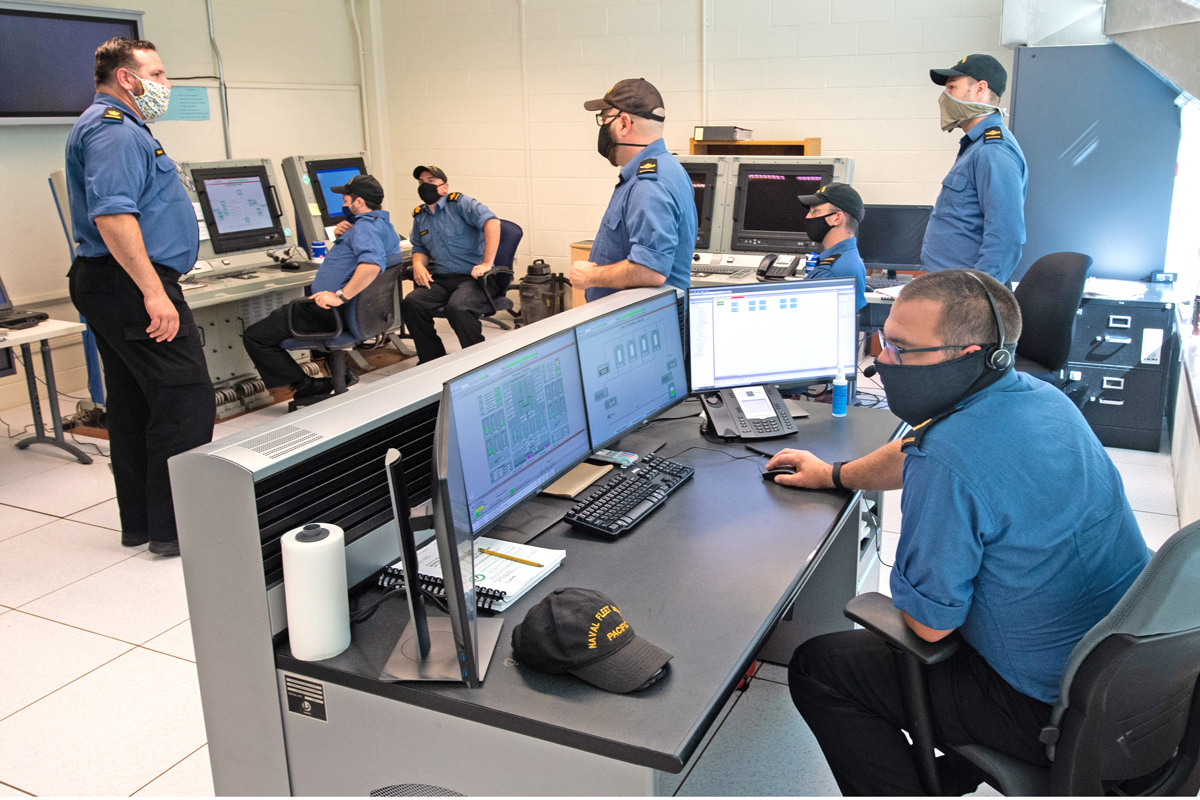Unprecedented times – gradual training restart
By Lookout Production on Jul 06, 2020 with Comments 0

Senior engineer watchkeeper students resume classroom instruction at Naval Fleet School (Pacific) on June 22. Schools are opening up at bases across the country as part of a gradual re-opening plan. Photo by Corporal Jay Naples, MARPAC Imaging Services
Peter Mallett, Staff Writer ~
Training for military members has started up with a gradual, phased re-opening of facilities across the country.
The Royal Canadian Navy (RCN), through the Naval Personnel and Training Group (NPTG), has reactivated its Naval Training System (NTS) in the first of a four-phase, conditions-based restart plan in accordance with public health guidelines.
“The restart of naval training is predicated on a set of deliberately selected and approved preconditions that places a premium on protecting the health of Defence Team members and civilian employees,” said Capt(N) Jason Boyd, Commander of NPTG.
The four-phase re-opening plan was announced following direction from the Chief of the Defence Staff on June 1. It was developed under the parameters of a COVID-19 persistent operating environment, coupled with the training system’s mandate to support fleet readiness and RCN Force Generation.
NPTG is headquartered in Esquimalt and is comprised of nine units located in three regions across the country – the Atlantic, Pacific and Quebec. In total, approximately 1,980 military and civilian staff support skills development and training through Naval Fleet Schools Atlantic, Pacific, and Quebec, Naval Training Development Centres Atlantic and Pacific, and Personnel Coordination Centres Atlantic, Pacific, and Quebec for about 8,200 students across the country in a typical year. Of that, 3,900 students receive training in the Pacific. This is, of course, not a typical year.
Phase 1 of the re-opening, or the Crawl Stage, saw the resumption of one course in each of Naval Fleet School (Pacific)’s five divisions: Marine Systems Engineering, Seamanship, Combat Systems Engineering, Combat, and Venture Division, with similar undertakings in the Atlantic and Quebec training centres.
The aim, says Capt(N) Boyd, is to restart courses that are less complex and short in duration, while testing procedures and protocols to ensure effective operation in a COVID-19-persistent environment.
NPTG is anticipating a switch to Phase 2 in late July. The Walk Phase is a tiered and prioritized ramping up of 42 training courses across Canada.
Additional increases in course offerings amongst training divisions, including those for Naval Reserve personnel, will occur in the Phase 3 Run stage with the caveat that force health protection measures can be met.
The fourth and final Steady State phase, says Capt(N) Boyd, will use lessons learned from the first three phases and will see increased training to levels that match or exceed pre-pandemic rates while adhering to provincial and municipal health and safety guidelines.
“Phase 4 will persist as long as the NTS is operating in a COVID-19 persistent environment and will be complete when signalled by me,” said Capt(N)Boyd.
Safety and protection measures
The adoption of public health measures as ordered by the CAF Surgeon General are being strictly adhered to and are non-negotiable, he says. Physical distancing by staying six feet apart is standard, and in situations where this is not possible, non-medical facemasks must be worn.
Classroom configurations have been designed to ensure physical distancing, with enhanced cleaning and sanitation measures to rid touch points of the virus.
Since the navy has never in its history shut down training operations, the restart plan was a massive and unprecedented undertaking; extreme caution and concern was always the overriding principle, said Capt(N) Boyd.
He also noted that because of the highly contagious nature of the COVID-19 virus, it wasn’t just the sailors’ and employees’ health that were being taken into account when drafting the reopening plan, it was also their families and the communities they live in.
“Really, in the end it is the virus that is in the driver’s seat and it will dictate how we do things,” said Capt(N) Boyd. “It doesn’t matter what mitigation we put in place, if trends indicate these measures aren’t working, we will act accordingly and will be taking the cues from public health officials.”
Filed Under: Top Stories
About the Author:





